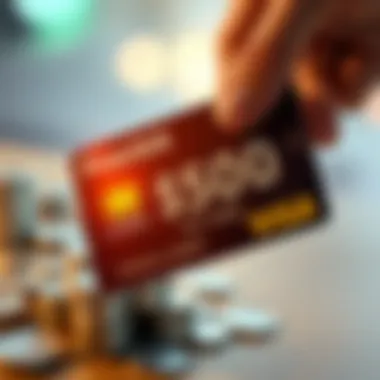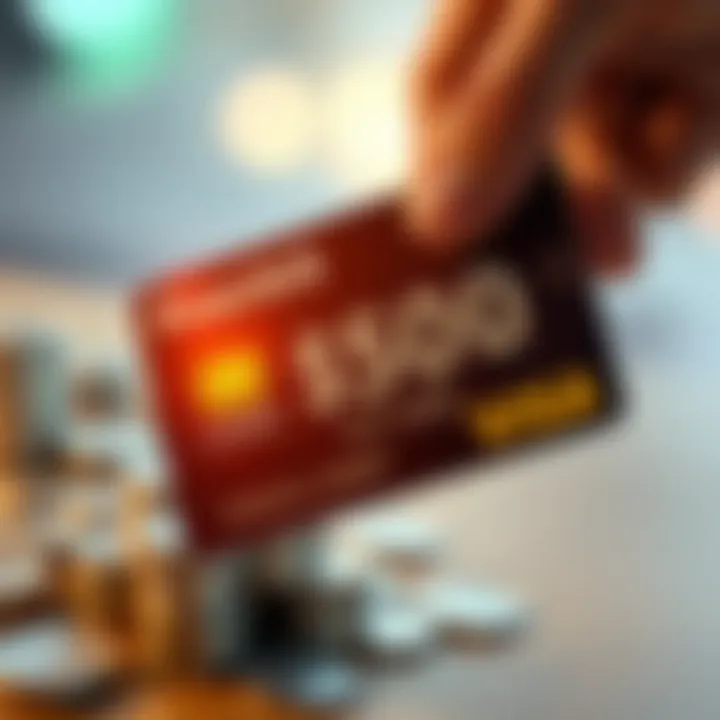A Thorough Look at $500 Unsecured Credit Cards


Intro
Navigating the world of credit can seem like an intricate dance, especially when it comes to unsecured credit cards. For many individuals, the $500 limit on these cards stands out as an entry point into financial freedom. What does it really mean to hold such a card? How does it fit within the broader spectrum of credit management?
In this guide, we will take a closer look at $500 unsecured credit cards, unpacking their features, benefits, and potential pitfalls. Whether you are a newcomer to credit or someone seeking to enhance their financial standing, understanding these facets is crucial.
The narrative we construct here is aimed at enlightening readers on the nuances of these financial products. From eligibility details to application processes, you’ll find a comprehensive breakdown that empowers you in your credit journey. In short, this is your roadmap to making informed decisions in navigating the sometimes bumpy road of credit management.
Understanding Credit Status
To kick things off, let’s delve into the concept of credit status, a pivotal aspect of credit management that deeply influences your access to financial products.
What is Credit Status?
Credit status is essentially a reflection of an individual’s creditworthiness. It determines how lenders view your ability to repay borrowed money. Unlike your credit score, which is a numerical value, your credit status encompasses a broader narrative—your history, habits, and behaviors concerning financial obligations.
Key Factors Affecting Credit Scores
While there's no magic formula, several key elements contribute to your overall credit score:
- Payment History: Timeliness in settling debts plays a crucial role.
- Credit Utilization: The ratio of your current credit balances to credit limits matters.
- Length of Credit History: Lengthy, responsible credit habits can boost your standing.
- Types of Credit: A diverse portfolio of credit types may favorably impact your score.
- Recent Inquiries: Multiple hard inquiries within a short time can negatively affect your score.
Importance of Knowing Your Credit Reports
Understanding your credit report is akin to using a compass in unfamiliar territory. It allows you to pinpoint areas needing improvement and helps guard against potential identity theft. Regularly reviewing this document gives you an idea of where you stand and can inform financial decisions down the line.
How to Obtain Your Credit Reports
In the US, you’re entitled to a free credit report from each of the three major bureaus—Experian, TransUnion, and Equifax—each year. It’s best to stagger these requests to keep an eye on your credit throughout the year. Visit annualcreditreport.com for more detailed information.
With an informed grasp of credit status, let's look at ways to actively improve your credit score.
Understanding Unsecured Credit Cards
The realm of credit cards can sometimes feel more confusing than a cat in a dog park, especially for those unfamiliar with the intricacies of unsecured credit products. Understanding unsecured credit cards is not just a journey through financial terminology, but a crucial step for individuals looking to improve their credit profiles without having to fork over hefty deposits. This section aims to illuminate the concept of unsecured credit cards, highlighting their significance in the broader financial landscape, particularly for those new to borrowing.
Definition and Functionality of Unsecured Credit Cards
Unsecured credit cards are financial tools that allow consumers to borrow money without requiring a security deposit as collateral. In simpler terms, they're like a chef’s knife in the culinary world—essential for preparing a wide variety of meals but requiring some skill to wield responsibly. When a person utilizes an unsecured credit card, they are essentially entering into a line of credit agreement with the issuer, which is promising to cover expenses up to a certain limit, typically $500 in this context. This credit limit is determined based on factors such as credit score and income.
The functionality of an unsecured credit card is rooted in lending principles that assume a level of responsibility on the borrower's part. Cardholders are expected to pay back their borrowed amounts, ideally in full, each month. Failure to do so can indicate potential financial distress, leading to interest charges and possible damage to their credit score. It's crucial for users to understand that their spending, primarily guided by the credit limit, directly affects their overall financial health and credit history.
How Unsecured Credit Cards Differ from Secured Credit Cards
Now, let’s untangle the nuances that set unsecured credit cards apart from their secured counterparts. Secured credit cards require users to put down a deposit that typically matches their credit limit, thus minimizing the risk to the lender. Think of it as a safety net; while it protects the bank, it can also seem like a financial hindrance to users who wish to start building their credit without tying up cash.
On the flip side, unsecured cards operate solely on users’ creditworthiness. This can often give consumers more freedom to manage their cash flow since they do not need to pay a sum upfront—yet with this freedom comes greater responsibility. The stakes are higher; if a borrower mishandles an unsecured card, they risk accruing debt and fees due to high-interest rates.
To summarize:
- Secured Cards: Require a cash deposit, which serves as collateral and minimizes lender risk.
- Unsecured Cards: No deposits needed, relying on the borrower's creditworthiness; higher risk for lenders.
"Using an unsecured credit card can pave the way for financial liberty, but it's a road best navigated with caution and understanding."
In both instances, the cardholder’s financial behaviors will impact their credit scores, but the pathways to attaining these types of credit will undeniably differ. Recognizing these distinctions is vital for anyone considering their options in the credit landscape.
The $500 Unsecured Credit Card Market
The significance of the $500 unsecured credit card market cannot be understated. This segment offers a lifeline for many individuals looking to build or rebuild their credit history without the constraints of collateral. In today’s financial landscape, where credit scores often determine access to loans and other financial products, understanding the nuances of this category becomes imperative.
Overview of $500 Credit Limits
An unsecured credit card with a limit of $500 can serve as a fundamental building block for those new to credit or for those looking to bounce back after financial setbacks. The essence of a $500 limit lies in its dual role as both a starting point and a safety net. It's not a huge amount, but it provides enough flexibility for everyday purchases while limiting the potential for excessive debt.
Using a $500 credit limit can help users manage their spending effectively. It instills discipline, encouraging cardholders to stay within their means while also starting down the path to positive credit behavior. However, remember that while it provides opportunities, the potential for overspending remains. One must tread carefully.


With this in mind, it's worthwhile to consider how the credit limit will affect your overall credit utilization ratio, which is a crucial metric for lenders. Keeping your balance well below the limit—ideally under 30%—can lead to improvements in credit score over time. In essence, this limit can serve as a stepping stone for greater financial independence.
Common Issuers of $500 Unsecured Credit Cards
The players in the $500 unsecured credit card arena are numerous, each with its unique offerings and terms. Common issuers include:
- Capital One: Known for its straightforward approach, it often caters to those looking to build credit without monthly fees.
- Discover: With a focus on customer rewards and excellent service, Discover maintains a range of options aimed at budget-conscious consumers.
- American Express: Although typically seen as a premium brand, they offer entry-level options with lower limits for those aiming to develop credit.
Each of these institutions provides something slightly different, catering to varying financial histories and needs. Before committing, it’s advisable to dive into the specific terms and conditions of each card. Look for details such as annual fees, interest rates, and whether they report to all three major credit bureaus, as this can significantly influence your credit-building journey.
In summary, the $500 unsecured credit card market plays a pivotal role for many, acting as a manageable entry point for consumers eager to strengthen their financial footing. With careful navigation, cardholders can not only gain purchasing power but also enhance their financial profiles over time.
Eligibility Criteria
Understanding eligibility criteria is key when it comes to applying for a $500 unsecured credit card. Knowing what lenders typically look for can help you prepare your application better and increase the chances of approval. There are several factors at play that can dictate whether your application will be successful or not. By breaking these down, we can shine a light on how to navigate the process with confidence.
Minimum Credit Score Requirements
To step into the realm of $500 unsecured credit cards, one of the primary gatekeepers is your credit score. Generally, issuing banks set a minimum credit score that applicants must meet to be considered. Most issuers are looking for a score of around 580 or higher. However, there’s always a bit of wiggle room depending on the lender’s policies and the specifics of your financial history.
But why is your credit score so important? Well, it serves as a snapshot of your financial reliability. If your credit score is low, it might signal to lenders that you’ve had difficulty managing debt in the past. But it’s not all doom and gloom; many issuers provide opportunities for those with imperfect scores, focusing instead on your overall financial behavior.
When it comes to improving your score, simple steps can make significant differences. Paying down existing debts, making timely payments, and checking your credit report for inaccuracies are just a few strategies to boost your standing.
A higher credit score can pave the way not just for credit cards but also for better interest rates on loans and mortgages.
Income and Employment Considerations
Alongside credit scores, lenders also take a gander at your income and employment history. They want to know that you have a steady income that can support regular payments on your credit card. Typically, a robust job history can work in your favor. Being employed in a steady role signals stability, which lenders favor greatly.
When applying, be prepared to disclose your income and possibly provide documentation such as pay stubs or tax returns. In cases where applicants are self-employed, tax returns and bank statements might be required to verify income levels.
What happens if you're a recent graduate or currently between jobs? While it may seem like a daunting journey, there are unsecured credit cards designed for individuals in such positions. These often carry slightly higher interest rates or less favorable terms but still provide an opportunity to build credit.
In short, having a consistent income and stable employment can bolster your application significantly. If you're looking to strengthen this area, consider seeking part-time jobs or freelance gigs that can show a history of income generation.
To summarize, meeting the eligibility criteria for a $500 unsecured credit card is essential to set yourself up for success in your credit journey. By understanding the credit score requirements and demonstrating financial stability through income and employment proof, you can better position yourself for approval.
Application Process
Understanding the application process for a $500 unsecured credit card is critical for anyone looking to improve their credit profile. This part of the financial journey can often feel daunting, especially for first-time applicants. However, grasping the nuances of this process can significantly enhance your chances of securing credit and lay a solid groundwork for future financial endeavors.
Steps to Apply for a $500 Unsecured Credit Card
Applying for a $500 unsecured credit card isn't as tough as it sounds. Here’s a clear roadmap to follow:
- Research Issuers: Different banks and credit unions offer various credit cards with $500 limits. Take time to review their terms, interest rates, and fee structures. Reputable sources like NerdWallet and Bankrate can offer insights into which institutions could suit your needs.
- Check Your Credit Score: Knowing your credit score before applying can be a game-changer. It allows you to set realistic expectations. Free resources like AnnualCreditReport.com give you access to your credit history once a year.
- Prepare Necessary Documents: Most applications require identification, proof of income, and possibly your Social Security number. Ensure you have these documents handy to make the process smoother.
- Online Application: Most issuers allow online applications. These tend to be straightforward; fill out your personal information, employment details, and income.
- Review Terms: Before you hit submit, double-check the terms of the card. Look out for interest rates, rewards, and any fees associated with the card.
- Submit Your Application: Once you’re satisfied that everything checks out, submit your application. This typically takes a few minutes. After submission, hang tight—all that’s left to do is wait for feedback.
What to Expect During the Approval Process
After submitting the application, you might find it surprisingly simple to navigate the approval landscape.
- Immediate Decision: Many issuers can provide an instant approval or denial decision. If your application is approved, you’ll often receive a notification quickly.
- Further Verification: Sometimes, the issuer may need more information. They might reach out via phone or email to confirm your identity or request additional documents.
- Waiting Period: If you do not receive immediate feedback, don’t fret. It can take anywhere from a few hours to several days for the final decision. However, during this time, gaining insight on other options might be wise just in case.
- Credit Limit Confirmation: If approved, you should receive a follow-up email or letter detailing your credit limit—this is where you'll find that $500 limit you were aiming for!
"Navigating credit options can be tricky, but being informed is the best strategy. Take charge of your financial wellness with the right steps!"
By thoroughly understanding the application steps and what to expect post-application, potential applicants can approach the situation with greater confidence. The key here is preparation and awareness, paving a smoother pathway to securing a $500 unsecured credit card.
Benefits of $500 Unsecured Credit Cards
Choosing a $500 unsecured credit card can impact financial health in various ways. These cards often serve as a stepping stone for individuals aiming to improve or establish their credit profiles. Let’s dig deeper into the specific benefits of these financial tools.
Building Credit History
When individuals opt for a $500 unsecured credit card, one of the primary advantages is the opportunity to build a solid credit history. Every responsible transaction contributes positively to your credit report.
- Payment History: Timely payments are a significant factor in credit scoring. By consistently making on-time payments with your card, you are likely to see your credit score steadily improve.
- Variety of Credit Types: Unsecured credit cards diversify your credit portfolio, which can positively influence your credit score. Experiencing different types of credit, like installment loans or previously secured cards, shows lenders a well-rounded financial history.
- Credit Utilization Ratio: Keeping the balance low with respect to the credit limit plays a crucial role. Using only a small portion of the $500 limit—ideally below 30%—is favorable. It suggests to lenders that you are not overly reliant on credit and can manage it effectively.


Of course, it takes time and discipline to see results. Patience is key when it comes to building a favorable credit history.
Flexibility in Spending
A $500 unsecured credit card offers a fair degree of flexibility in how you manage your finances. This can be particularly advantageous for those who might find traditional banking services restrictive.
- Emergency Expenses: Having access to credit can be a lifesaver in case of unexpected expenses, like medical bills or car repairs. It allows for quick access to funds when cash flow might be tight.
- Everyday Purchases: These cards can cover regular expenses like groceries or gas. For many, this can simplify budgeting, as you can strategically plan repayments around your payday.
- Online Shopping and Safety: An unsecured credit card also enables safer online transactions compared to debit cards. It can be beneficial if fraud occurs, as you're not directly accessing your bank account.
In summary, the advantages of having a $500 unsecured credit card revolve around not just the immediate flexibility it provides, but also the long-term benefits of building financial standing. It allows users to navigate both everyday expenses and larger financial needs, all while enhancing their credit profiles.
Ultimately, leveraging these cards responsibly can empower individuals to take charge of their financial future, turning potential struggles into avenues for growth.
Potential Drawbacks
When considering a $500 unsecured credit card, it’s crucial to weigh the potential drawbacks. While these cards can be a helpful tool for building credit and enhancing financial flexibility, they come with specific challenges that users should be aware of. Understanding these risks can empower consumers to make informed financial decisions and navigate the credit landscape with far more confidence.
High Interest Rates and Fees
One significant concern surrounding $500 unsecured credit cards is their high interest rates and fees. Unlike secured credit cards, which require a deposit that acts as collateral, unsecured options often carry higher interest rates due to the increased risk to the lender. This can affect your overall costs if you carry a balance over time.
- Average Interest Rates: Many unsecured cards target those with limited credit history, leading to annual percentage rates (APRs) that could be significantly above the market average, often falling between 20% to 30%. This can compound quickly if the balance isn't paid in full.
- Additional Fees: Beyond interest, these cards can come with a host of fees such as annual fees, late payment fees, and foreign transaction fees. Some issuers even impose cash advance fees that might catch users off guard, contributing to financial strain.
It's essential to read the fine print and understand the full cost of using a $500 unsecured credit card. Some users may find themselves in hot water simply because they didn’t grasp how fees and interest work together.
Risk of Accumulating Debt
Another alarming downside relates to the risk of accumulating debt. The convenience of having a $500 credit limit can lead to overspending, especially for those who might still be learning to manage their finances effectively.
- Spending Beyond Means: It can be all too easy to view available credit as free money, leading to purchases that are not budgeted for. The allure of instant gratification can push one to buy items that are better saved for. This mentality often lacks consideration for future repayment, causing consumers to find themselves treading water under a growing debt burden.
- Cycle of Debt: Once a balance exists, the combination of high interest rates and fees can create a cycle of debt that is hard to escape. For instance, paying just the minimum monthly payment prolongs the payoff period and adds up to substantial interest charges over time, delaying one's ability to achieve other financial goals.
In the end, using a $500 unsecured credit card responsibly is paramount. Being aware of both the interest and the pitfalls of overspending can ensure that consumers are better equipped to maintain their financial health.
"Understanding the risks of your financial choices sets the groundwork for better, more strategic decision-making in the future."
By considering these potential drawbacks carefully, users can strategize their approach, ensuring that they use these financial products to their advantage rather than falling into common traps.
Responsible Usage Strategies
Navigating the world of credit cards can feel like a minefield, especially when it comes to managing a $500 unsecured credit card. Responsible usage strategies become pivotal in ensuring that you harness the potential of this financial tool without falling prey to common pitfalls. Recognizing the importance of these strategies can empower individuals to not only foster good financial habits but also make the most out of their credit card experience.
Setting a Budget
When it comes to managing a credit card effectively, setting a budget is not just a suggestion—it's a necessity. A well-defined budget serves as a roadmap, guiding your spending behavior and ensuring you don’t drift into the risky waters of excessive debt. Given that the limit on a $500 unsecured credit card is relatively low, creating a strategic budget can be straightforward.
- Track Your Income and Expenses: Begin by analyzing your monthly income against all your necessary expenses. This will give you clarity on how much you can reasonably allocate towards credit card spending each month.
- Allocate Wisely: Allocate a fixed amount for credit card use within your overall budget. It's crucial to select a sum you can afford to pay off each month without straining your finances.
- Adjust As Necessary: Life is inherently unpredictable. If your circumstances change—an unexpected expense or a change in income—don't hesitate to reevaluate and adjust your budget accordingly.
By clearly delineating how much you can and should spend, you create a buffer that helps you stay within the confines of your means, reducing the potential for overspending.
Timely Payments and Interest Management
Failure to make payments on time can snowball quickly into a costly affair. The late fees in combination with high-interest rates can make even a small balance difficult to manage. Therefore, timely payments are non-negotiable.
- Set Reminders: Utilize technology to your advantage. Calendar alerts or apps can serve as timely nudges, ensuring you don’t miss a payment due date.
- Automate Payments: Consider setting up automatic payments, which can contribute to your peace of mind. It guarantees that at least the minimum payment is made on time, maintaining your credit score's health.
- Understand Interest Rates: Familiarize yourself with the terms of your credit card agreement. Knowing how interest accumulates each month can motivate you to pay off balances in full—avoiding the trap of high-interest accruals.
- Pay More Than the Minimum: If possible, always try to pay more than just the minimum payment. This approach not only saves you interest but also helps in clearing your debt faster.
"The best way to treat your credit card is like a friend you must impress. Always pay it back, take care of it, and it will work out well for you."
By implementing these responsible usage strategies, cardholders can ensure they maximize the benefits of their $500 unsecured credit cards while protecting their financial wellbeing. The balance between enjoying the perks and managing the responsibilities is critical for successful credit management.
Impact on Credit Score
Understanding how a $500 unsecured credit card can impact your credit score is fundamental for anyone looking to build or repair their financial standing. Your credit score acts like a financial report card, influencing your ability to gain loans, secure mortgages, and even get certain jobs.
Credit scores range from 300 to 850, with higher scores indicating better creditworthiness. When it comes to $500 unsecured credit cards, there are two main elements that frequently come into play: credit utilization and payment history. Grasping these facets will help you navigate the path of credit management more effectively.
How Credit Utilization Affects Your Score
Credit utilization is crucial in determining your credit score, representing the ratio of your current credit balances to your total available credit limits. For example, if you have a $500 credit limit but are carrying a $250 balance, your utilization rate would be 50%. Most experts recommend keeping your credit utilization below 30% for optimal score maintenance.


Why does this number matter? Essentially, lenders view low utilization as a sign of responsible credit management. Higher utilization rates, often seen with overspending or lack of financial discipline, can indicate potential difficulties in repayment, immediately drawing the attention of lenders to the possibility of increased risk.
Here's a simple breakdown:
- Keep It Low: Aim to keep your balance below $150 on a $500 card to maintain a 30% utilization.
- Spending Smartly: If you must utilize more, pay down your balance frequently to avoid high utilization.
- Impact Over Time: A consistent pattern of low utilization can bolster your credit score in the long term, enhancing your financial opportunities.
"Credit utilization is one of those factors that, when understood, can help shift the scales in your favor when it comes to your credit score."
The Importance of Payment History
Payment history is perhaps the most significant factor affecting your credit score, comprising about 35% of its calculation. Each time you make a late payment or miss a payment altogether, you leave a blemish on your credit report that can haunt you for years.
For $500 unsecured credit cards, some simple guidelines can create a stellar payment history:
- Timeliness is Key: Always aim to pay your bill on or before the due date. Setting up automatic payments can help ease the burden of remembering.
- Pay More than the Minimum: Going over the minimum payment can showcase your commitment to managing debt effectively. Plus, it reduces your overall balance faster.
- Be Mindful of Late Fees: Late payments not only result in fees but can also jumpstart the countdown of negative marks on your credit report, typically lasting up to seven years.
These two aspects—credit utilization and payment history—work hand in hand to shape your overall credit score. Mastering both can not only provide better access to financial products in the future but can also save you money through lower interest rates. Prioritizing responsible credit card usage will serve you well as you navigate the complex world of financial management.
Comparative Analysis with Other Credit Options
When it comes to managing finances, understanding how your $500 unsecured credit card stacks up against other forms of credit is crucial. This comparative analysis sheds light on the features and functionalities of different lending products, thus aiding consumers in making well-informed decisions. You might be drawn to a $500 unsecured credit card for its convenience and ease of access, but it’s wise to weigh it against personal loans and store credit cards, which could cater to specific needs more effectively.
Comparison with Personal Loans
Personal loans are often seen as a go-to option for those in need of lump-sum funds. Here’s what people need to know:
- Borrowing Limits: While $500 is the typical limit for an unsecured credit card, personal loans can range from a few hundred dollars to tens of thousands, depending on creditworthiness. This flexibility may suit certain large expenses better.
- Interest Rates: A significant consideration when comparing the two is the cost of borrowing. Unsecured credit cards often come with higher interest rates, fluctuating around 15% to 30%, while personal loans typically have lower fixed rates, sometimes below 10%.
- Repayment Terms: Personal loans usually have fixed repayment schedules, often over several months to a few years. In contrast, credit cards allow for more flexibility, letting users pay down the balance at their own pace. However, this flexibility can lead to more significant debt if not managed well.
- Credit Score Impact: Using credit cards responsively can enhance your credit score. On the flip side, personal loans are reported to credit bureaus and can also boost scores if paid on time.
- Fees and Penalties: Credit cards often come with added fees like late payment and over-limit charges. Personal loans may have origination fees but generally lack the ongoing fees associated with credit cards.
These distinctions make it imperative to assess your immediate financial needs. If you need a small, short-term borrowing solution, an unsecured credit card could be easier to manage. But if you've got a bigger purchase in mind that you want to pay off over time with fixed payments, a personal loan might be your best bet.
Evaluating Against Store Credit Cards
Store credit cards might seem tempting, especially with the special deals they often provide. Here’s a deeper dive into how they compare to $500 unsecured credit cards:
- Reward Structures: Store credit cards frequently offer loyalty rewards or discounts for in-store purchases. If you’re a regular shopper at a particular retailer, this can translate into considerable savings. However, the catch is that these rewards can usually only be redeemed within the store of issuance—a limitation that doesn’t apply with most unsecured credit cards.
- Interest Rates: Similar to unsecured credit cards, store cards also bear high interest rates, usually above 20%. However, they can come with enticing promotions of zero-interest for initial purchases, which can be beneficial if paid off within that window.
- Limited Usability: A significant drawback of store credit cards is their limited acceptance. While your $500 unsecured card can be used almost anywhere that accepts credit cards, store cards confine you to a single or a limited group of retailers.
- Credit Score Impact: Both options can impact your credit score positively when handled carefully. However, a store card can potentially harm your credit further if it leads to overspending within that retail space.
- Initial Credit Checks: The restrictions in approval for store credit cards can sometimes be less stringent compared to broader unsecured credit cards. This could be advantageous for those trying to build their credit history with a limited score.
In summary, while both personal loans and store cards have their own advantages, a $500 unsecured credit card allows for better flexibility and broader usability. It all boils down to assessing your financial strategies and understanding what aligns best with your needs. Prioritizing financial responsibility is essential, regardless of the credit option you choose.
Frequently Asked Questions
Frequently asked questions (FAQs) serve as a bridge connecting consumers with important information about $500 unsecured credit cards. In this section, we will delve into some of the most common inquiries regarding these financial products, bringing light to various concerns that potential users often have. Knowing the ins and outs can simplify the decision-making process for many individuals navigating the often confusing credit landscape.
Common Inquiries About $500 Unsecured Credit Cards
When exploring the world of $500 unsecured credit cards, many individuals seek clarity on specific aspects to ensure they are making informed decisions. Here are some of the typical questions:
- What is the difference between unsecured and secured credit cards?
Unsecured cards don’t require a cash deposit as collateral, whereas secured cards do. This distinction is vital for consumers who may prefer more flexible spending. - Can I improve my credit score with a $500 unsecured credit card?
Yes, using a $500 unsecured credit card responsibly by making timely payments and keeping your credit utilization low can gradually enhance your credit score over time. - What fees should I expect?
Fees can vary widely by issuer, but common ones include annual fees, late payment fees, and potentially higher interest rates. Always read the fine print to avoid unpleasant surprises down the line. - Is there a minimum credit score needed?
While many $500 unsecured credit cards target individuals with fair to good credit, some may have minimal credit score requirements, which can vary greatly across different lenders. - How long does it take to get approved?
Approval times can differ from a few minutes to several days, depending on the issuer and the application’s thoroughness. Always keep an eye on your email or application dashboard for updates.
Misconceptions and Clarifications
As with any financial product, there are misconceptions surrounding $500 unsecured credit cards. Clearing up these misunderstandings is crucial for potential applicants to make educated choices. Here are some clarifications:
- “I need excellent credit to get a $500 unsecured credit card.”
This isn't necessarily true. Many issuers cater to those with average credit, so it’s worth exploring your options even if you think your credit isn't top-notch. - “These cards are only for people in debt.”
Quite the opposite! Many use these cards to establish or rebuild their credit history without requiring a deposit. - “Interest rates are always high.”
While it’s common for unsecured credit cards to carry higher rates than secured ones, there are still options with competitive rates. Consumers should shop around and compare rates before committing.
"An informed consumer is the most powerful advocate in financial decisions."
- “Once I have the card, it's all smooth sailing.”
Not at all! Responsible usage, such as making on-time payments and avoiding going over the credit limit, is crucial to maintaining good credit health.
Understanding these common inquiries and misconceptions not only helps potential cardholders navigate the $500 unsecured credit card market more effectively, but also equips them with the knowledge needed to improve their financial literacy. It’s essential to engage in a thoughtful exploration of any financial product to ensure it aligns with your personal goals and circumstances.
Ending
In the realm of personal finances, understanding the nuances of $500 unsecured credit cards is paramount. These financial instruments serve a dual purpose: they not only provide a means of access to credit but also play a significant role in shaping one’s credit history. As consumers increasingly navigate a world full of complex financial decisions, having a clear grasp of how these cards function, their benefits, and potential pitfalls can empower them to make informed choices.
The essence of using a $500 unsecured credit card lies in responsible management. Many users may view such cards as mere expendable resources, yet, treating them with care can yield long-term rewards. For instance, timely payments have the potential to uplift one’s credit score, while reckless spending can catapult consumers into cycles of debt. Ultimately, financial literacy transforms the act of using credit into a strategic advantage rather than a reckless gamble.
Summarizing Key Takeaways
- Accessibility: $500 unsecured credit cards offer a pathway to credit for individuals who may not qualify for higher limits or who wish to build their credit without collateral.
- Credit Building: Regular, responsible use of these cards can aid in developing a robust credit history, which is essential for future borrowing.
- Flexibility: They provide a degree of spending flexibility, enabling users to make necessary purchases without carrying cash.
- Risks: High-interest rates can trap users in debt if not managed properly, making it critical to be aware of one’s spending habits and payment timelines.
- Application Process: Understanding the eligibility criteria and application steps is crucial to increasing the chances of approval and effectively using the financial tool.
Final Thoughts on Using $500 Unsecured Credit Cards
Navigating the waters of credit management can often seem daunting; however, $500 unsecured credit cards can be a useful tool for those willing to tread carefully. They are not only an instrument for immediate financial relief but also a stepping stone toward future financial opportunities.







